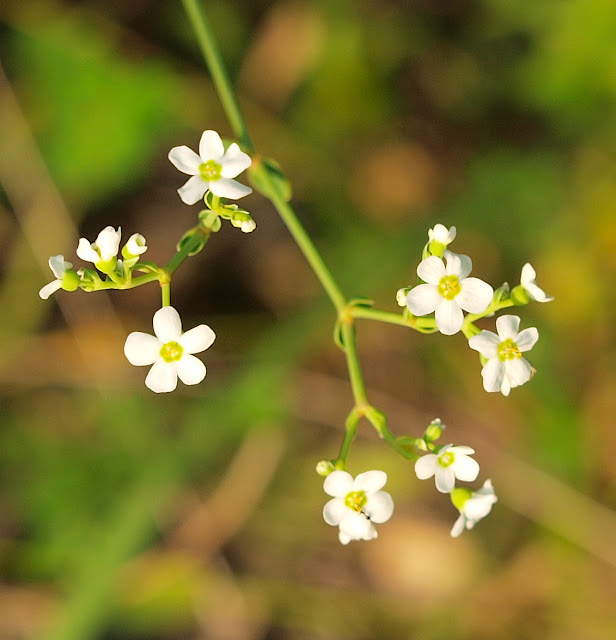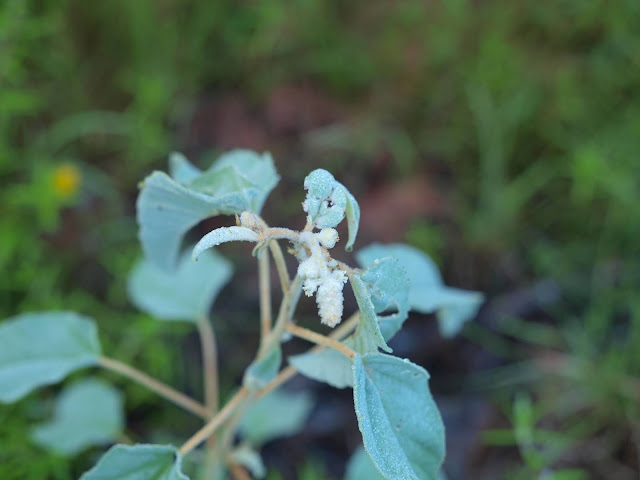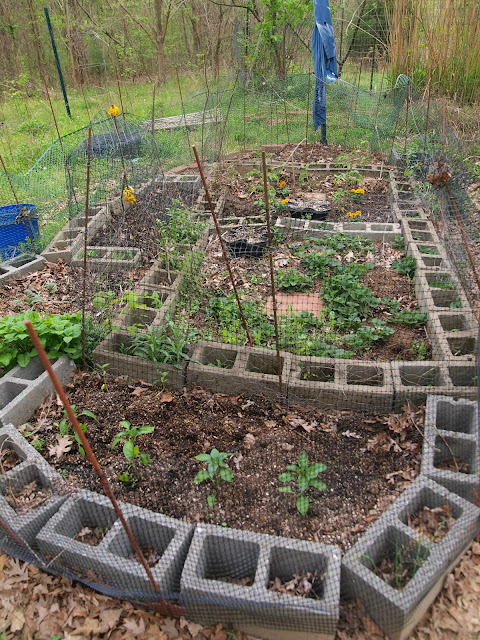Galium or Bedstraw on August 11th
Sometimes, you've got to look twice. There is something about this plant, and the way it emerges at this time (late July to early August, with many other butterfly plants) that made me take a second look at it today. It looks inconspicuous, growing about a foot high on the side of the road among the grass. The leaves reminded me of lespedeza, but the flower structure was more like baby's breath. In days past, I would have just kept walking because it was a 'little flower'...(in fact one site called it 'green noise!') But - this morning, I noticed the little clusters of flowers were being visited by many small bluewing and white moths, and had many small bees and ants crawling near them. I thought, there has to be more than meets the eye about this!
family Rubiaceae, also containing madder plants and coffee trees!
best guess: Galium album, common bedstraw, heath bedstraw
Galium is a very important pollinator plant in the life cycle of moths and butterflies. It might not look like it, but it has an important job to play!
This is a slightly different but similar version of the plant. If you look at the right side of the flower clusters, there is a tiny bee of some sort hiding behind a flower!
The reason I put it as 'best guess' is because most Galium or bedstraw varieties have only four petals. I've seen listed that 'five sepal (petaled) specimens are uncommon, but do occur'. Well, that is why I spent an hour looking for this one! Everything else matched, except the number of petals. It also states that it is even rarer, but you could find a specimen with 'four and a half petals' - four and a fifth fused with the fourth. It all depends on how the plant develops. It is a small change, I would think, in the genetics like when a person might have six fingers or a dog have an extra dewclaw.
The way the plant has two leaves at the base of each separation, and the leaf type and structure most closely resemble the Galium album. Also, the plant is native to Tennessee and prefers to live in moist woodlands and roadsides. This is exactly the environment I have noted it in. It was a close neighbor of a large Joe Pye Weed plant, which also prefers the same environment.
Bedstraws also have some herbal uses, like it's cousin 'red madder' the root can be used for a red dye, and some other uses.
I will have to say I need to look more into the Evening Primrose that has popped up this year, though. This article from Nurturing Nature states that sometimes Hummingbird moths can get their proboscis 'stuck' in the flower and die, because it opens and shuts depending on the time of day. It states a white Evening Primrose, and ours are yellow - but it would be worth looking further into.
Almanac: There was a huge storm headed into Paris and Camden, TN today. The lightning and thunder were impressive, and we got more water dumped on us than we've had all the previous week. Everything in our garden needed it. The elephant ears were actually laying down flat on the ground in the afternoon.
The Grandpa Ott morning glories are still blooming every morning, but the Heavenly Blue and moonflower are still in the vegetative state. Zinnias are starting to bloom finally, and the marigolds from seed are just starting to get ready to form heads. The butterfly flower in the garden is still in bloom, as is the one in the woods. The whipporwill cowpeas are podding, but the regular green beans are still in the flowering and vegetative states - while I've seen neighbors posting piles of green beans on their tables. Mark reminds me that with our ridge and cedars we are actually 'one zone colder' than most of our neighbors - the weather just acts different here on Pea Ridge.
I've been noting a number of plants in the meadow that are all blooming at this time, and will be featuring them as time allows. What has really piqued my interest this week is that this is THE time for butterfly pollinators, like the bedstraw and croton, to be blooming mostly unnoticed by humans. There are whole ranges of plants from tiny roadside to tall marsh plants that are all catering to the butterflies, providing nectar for them at this stage of their lifecycle. There are also a wide range of different butterflies and moths present all at the same time right now - some of them depend highly on these plants we might not otherwise notice (and might be mowing down, without knowing!)
What I have documented blooming at this time are
goldenrod : meadow
tall lobelia campanula: moist woodland edge, meadow edge
woolly croton (hogwort) : woodland edge, meadow
horse nettle : meadow, woodland edge
trumpet flower : woodland edge
ipomoea pendulata : woodland edge
Joe Pye Weed : moist woodland edge, riverbanks
white sweetclover (melliotus alba) : roadside edge meadow
galium album (bedstraw) : moist woodland edge
desmodium ciliare (locally called a sweet pea, but actually a beggar's lice): moist woodland edge, roadside edge, riverbanks
asiatic dayflower : roadside edge, oak environments
local milkweed butterfly flower AND garden tropical butterfly flower (differences)
butterfly pea : riverbanks
there are several others I have pictures of but am working for an identification








Comments
Post a Comment